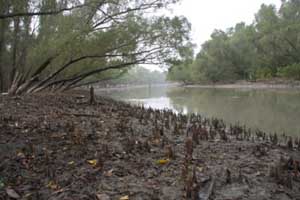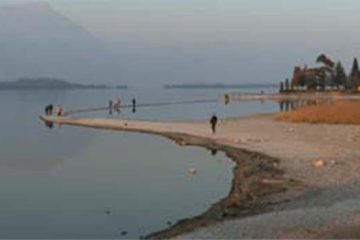Muhammad Selim Hossain and Mohammed Abdul Baten for The Daily Star
 Forest is a bounteous gift of nature that provides the basis of life and livelihood for humans. According to human history, hunting and gathering, the first and foremost livelihood of homo sapiens, was forest based. Interestingly, mangrove is the most diverse forest and is maximum service provider of all the forest types. Today, it is man whose relentless activities are, however, at the root of eroding this invaluable biological capital of nature.
Forest is a bounteous gift of nature that provides the basis of life and livelihood for humans. According to human history, hunting and gathering, the first and foremost livelihood of homo sapiens, was forest based. Interestingly, mangrove is the most diverse forest and is maximum service provider of all the forest types. Today, it is man whose relentless activities are, however, at the root of eroding this invaluable biological capital of nature.
Forest management has also seen a long chronological development even in Bangladesh. Unfortunately forest has always been valued by its wood, food, fuel-wood and the like contribution to human well-being. Having no monetary value in the commercial markets, forest’s ecological services that help keep the environment supportive of life and living have hardly received attention of all concerned and particularly the policy makers.
UN had rightly put the theme of this year’s World Environment Day ‘Forests: Nature at Your Services’ to highlight the importance of different services of forests, including the ecological ones, to mankind. This write-up intends to elucidate the ecological services provided by the Sundarbans, the world’s largest single tract mangroves, on an area of 10,029 sq km between India and Bangladesh, to find their monetary value for promoting better understanding of the need of its conservation in real sense.
Aquatic and terrestrial species: Biological resources are a natural power-house. The Sundarbans, a forest ecosystem full of life, energy and enthusiasm, provides habitats for about 6540 species, both aquatic and terrestrial. About 5,700 species are of vascular plants and 840 species belong to the forest wildlife (Akhond, 1999). The mangrove wildlife habitats provide both food and shelter to organisms. For some species, especially plants, a particular mangrove may provide every element required to complete their life cycle.
Other species depend on the mangrove area for part of a more complex life cycle. Many aquatic animals such as fish and prawn depend on mangrove areas for spawning and juvenile development. Many species of migratory birds depend on mangroves for part of their life cycle like resting or feeding while on migration. The microorganisms eat the mangrove’s leaf litter, and in turn are eaten by juvenile fish and shrimp (The Shedd, 2011). The mangrove forests, thus, facilitate the continuation of life cycle of innumerable organisms which greatly contributes to keep ecological equilibrium
Biomass and productivity: In an ecosystem, biomass represents the base of food chain. The standing stock of mangrove plant biomass combined with nutrients, water, and light maintains the existing biomass, grow new biomass, and support the rest of the food chain. Plant biomass is also important as a structural, abiotic feature in the landscape. It can perform physical as well as biological functions, like trapping sediments and serving as nesting sites for animals.
Erosion control: In the first place, the mangroves in Sundarbans contribute to limiting erosion of soil. The land of mangrove ecosystem is moulded by tidal action, developing a distinctive physiography. An intricate network of interconnecting waterways run in a generally north-south direction, intersecting the whole area. The water which enters the forests from upstream can easily run downstream without making extreme pressure on forest terrestrial part.
Climate regulation: The importance of forests stretches far beyond their own boundaries. The forest plays a vital role in the battle of halting climate change induced damage because they store nearly 300 billion tons of carbon in their living parts — roughly 40 times the annual greenhouse gas emissions from fossil fuels (Green Peace International, 2011). Mangroves is pioneering forest type that acts as giant carbon storage. According to the study conducted by Donato, D. C. et al. in 2011, mangroves are among the most carbon-rich forests in the tropics, containing on average 1,023?Mg carbon per hectare. Taking this datum into account, the total carbon storage of Bangladesh Sundarbans stands at about 615.5391 million Mg.
Protective role: Mangroves plays a great part in shoreline stabilization. This is achieved through the binding and cohering of soil by plant roots and deposited vegetative matter, the dissipation of erosion forces such as wave and wind energy, and the trapping of sediments. Thus the intricate root system not only protects the shoreline from erosion but also adds land. The mangroves reduce the intensity of cyclone and tidal surge acting as a natural barrier for the coastal human habitations. After the super cyclone Sidr, the protective role of the Sundarbans was widely felt. It is commonly assumed that the damage from cyclone Sidr and Aila would be many times higher without the Sundarbans.
Sediment and nutrient retention: The physical properties of mangroves like vegetation and water depth tend to slow down the flow of water. This facilitates sediment deposition. The sediment retention function of mangroves may have two important effects. Firstly, it may lead to accretion of arable land within mangrove areas. Secondly, it may protect downstream economic activities and property from sedimentation. Thirdly, it may accomplish beneficial removal of toxicants and nutrients since these substances are often bound to sediment particles. Sediments trapped by roots prevent silting of neighbouring habitats.
Nutrient cycling: Nutrient loading, a common type of pollutant in the air, water, and soil can influence organisms in many different ways, from altering the rate of plant growth to changing reproduction patterns in certain extreme situations, leading to extinction. Organic nutrients, including those from humans and animal waste, are often trapped by mangroves. Micro-organisms in soil and on roots also remove toxins and nutrients, providing another natural filter in the mangrove muck. Nutrients are often associated with sediments and therefore can be deposited at the same time.
The value of nutrient cycling function of mangroves will be obvious to us if we replace this function with the cost of waste treatment operation (Bann, 1998).
Water regulation: Mangroves help accomplish both recharge and discharge of ground water. Water moves from the mangroves to an aquifer that can remain as part of the shallow groundwater system and may supply water to surrounding areas to sustain the water table, or it may eventually move into the deep groundwater system, providing a long term water resource. This is of cracking value to communities and industries that rely on medium or deep wells as a source of water.
Ecological services: For recognizing the ecological services of forests, particularly mangrove forests, efforts have hardly been made even at the global level let alone at the national and individual ecosystem level. Although United Nations Environment Programme (UNEP) has undertaken a large project entitled “The Economics of Ecosystem and Biodiversity (TEEB)” in 2007 to value overall services of different natural ecosystems, till today it has succeeded to evaluate services of a few ecosystems not on regional but on global scale. However, an attempt has been made here to determine the annual economic value of the ecological services of Bangladesh Sundarbans using the forest services valuing rates calculated by Costanza in 1997 and accordingly the total value of the ecological services of Bangladesh Sundarbans stands at about USD 379.67 million.
Concluding remarks: The Sundarbans is one of the most biologically productive natural ecosystems. In the face of numerous challenges, both nature and human induced, it has been more than imperative to determine its total contribution to the well-being of society in terms of economy, ecology and culture with the aim of raising awareness of all concerned including local stakeholders regarding how worthy the mangrove forest is to us. Accordingly, valuing ecological services of the Sundarbans in Bangladesh is a demand of the hour. This is International Year of forests. It is a unique opportunity to boost understanding of the mangrove ecosystem in Bangladesh: To disseminate information and to promote its restoration and conservation campaign finding the monetary value of all the services including the ecological ones that the forest provides on continuous basis.
The writers are researchers at Unnayan Onneshan. They can be reached at ms.hossain@unnayan.org and a.baten@unnayan.org respectively.



